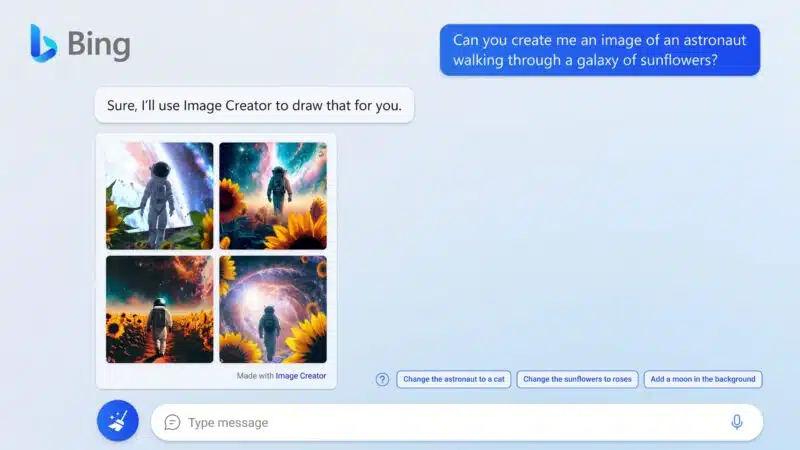As the AI race intensifies, Microsoft Bing has just added another tool to its arsenal — an image creator that runs off an “advanced version” of OpenAI’s DALL-E system, a deep learning model that produces images from prompts.
The new image creator will be integrated into Bing Chat, Microsoft’s version of ChatGPT, and will let users make original, photorealistic images by adding a description, context, and an art style of their choice.
With Google processing 6.9 billion searches daily, compared to Bing’s modest 900 million, Microsoft isn’t expecting to take over the giant’s market dominance any time soon. However, with Google’s Apprentice Bard falling by the wayside, can we expect users to jump ship?
A New AI Photo Generation Feature Is Coming to Microsoft Bing
As Microsoft strengthens its investment in OpenAI technology, its search engine Bing has just launched a feature that let users create images through generative AI.
According to Yusef Mehdi, Microsoft’s head of consumer marketing, the new tool is powered by an advanced version of OpenAI’s DALL-E, which is an AI system that creates hyper-realistic images and art from language descriptions.
“Powered by an advanced version of the DALL∙E model from our partners at OpenAI, Bing Image Creator allows you to create an image simple by using your own words to describe the picture you want to see.” – Microsoft blog post
Just like DALL-E, the applications of Bing’s new feature are essentially limitless, and it’s fairly straightforward to use. Users just need to describe the kind of image they want to create on Bing Chat and provide some additional context if necessary.
This new capability will be available to everyone using the new Bing preview and is initially being introduced in the platform’s Creative mode. However, those who don’t have access to Bing Preview are also able to use the feature for text-to-image creation at bing.com/create.

The roll-out of this new feature comes just a month after Microsoft launched Bing Chat, an AI-powered assistant that has already facilitated over 100 million conversations. According to the company’s blog post, this DALL-E adjacent feature aims to elevate the chat experience further by making it more visual.
Could Bing’s Enhanced AI Tools Give it the Edge Over Google?
As Microsoft takes leaps and strides forward in the field of generative AI — thanks in no small part to OpenAI’s cutting-edge technology — the same can’t quite be said about Google.
Despite claiming to be an “AI-first” company, Google’s share prices plummeted when their own ChatGPT-like bot Bard failed to answer a simple request in a live demo. Following this embarrassment, and the storm of negative PR it created, Google’s CEO Sundar Pichai sent out an internal memo that instructed company employees to dedicate two to four hours to improving the chatbot each week.
On top of adding pressure to its workforce, the search monolith also recently invested $300 million in the AI start-up Anthropic, which was founded by a former employee of OpenAI. This investment falls majorly short of Microsoft’s recent $1 billion partnership with OpenAI, and it shows in Google’s limited chatbot technology.
However, despite Google’s shortcomings, Mark Riedl, professor at the Georgia Institute of Technology doesn’t think the search engine has anything to worry about.
“I do not believe the new version of Bing leveraging large language model technology will turn out to be a serious threat to Google’s search business” he tells The Guardian “Google has large language model technology that is at least on par with that from Microsoft and OpenAI.”
With AI technology considered to be the next digital frontier, the race to be the default AI search engine is anyone’s game. Yet, as investments in tech picks up the pace, one thing is certain — we’re going to be seeing a lot more advances in the field moving forwards.




